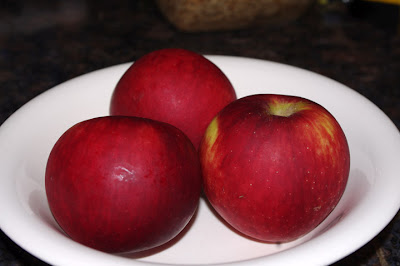Prior to 1900 there were over 8,000 varieties of apples. 8,000! That’s an amazing amount! But the vast majority of those varieties have become extinct and the others are quickly fading away. There appears to be only about 700 varieties left in private and public collections. Such a shame!
 |
| Arkansas Black Apples |
I’m picky about my apples I like them crisp and tart. I’m usually relegated to Granny Smith apples. The commercially available varieties of apples are very limited. And I don’t know why. There are so many varieties out there that are amazing. Even some of the varieties I used to see as a kid, like Pippin and McIntosh, aren’t easy to find anymore.
Last weekend on our way back from Mendocino we stopped at an apple orchard stand called Gowan’s Oak Tree Stand. They had dozens of varieties of apples available (but actually grow 60 different varieties), some of which I had never seen before. Some I had only heard of, like the Pink Pearl and Arkansas Black, others I hadn’t. It was the Arkansas Black I wanted to try. I wish I had also grabbed a couple of Pink Pearl apples as well to see their pink flesh – definitely a novelty apple.
They only had a large bag of Arkansas Black apples available. So I scooped them up and bought them. They were fairly small apples. Once in the car I pulled one out of the bag and crunched into. Hard. Very crisp. Slightly dry but with a subtle tartness followed by sweetness. Definitely an apple I can eat. I turned to Tom and said “We’re planting one of these.” He rolled his eyes, “I know.” I’d even go so far as to pull out our Granny Smith apple and replace it with one of these if I absolutely had to. Fortunately we won’t have to go to that extreme.
Growing different varieties of fruits and vegetables, particularly heirlooms and open pollinated varieties, is incredibly important, not only for genetic purposes, but also for preserving our heritage.
We currently have 3 apple trees. A Granny Smith, a Fuji and an unknown cider apple tree that has been grafted from one of the original Johnny Appleseed trees found in Ohio. I think we can find a spot for this heirloom tree as well.


You should definitely get a pink pearl. We planted one on a recommendation without having tried it and couldn't be happier. It has a beautiful pink marbled flesh and is a very tart apple. Crisp and good for eating fresh if you enjoy tart, and also a great cooking apple. It holds it's shape when cooked which is great for pies & tarts but also maintains a bright pink color after cooking which makes eye catching desserts and beautiful pink apple sauce and apple butter. We are growing it in Oakland so I'm sure it would be fine there. Also, it is very early season, so with your other apples especially the late fuji you will have a very long apple season.
I love the old apple varieties and some of the "newer" ones from the 40's like the Mutsu…it's tart and crisp and gets sweeter as it ages so it becomes a great cooking apple too….yum!
Check out the episode of California's Gold where Huell visits the apple place down in San Bernadino County… I learned so much about apples watching that. Oak Glen, that was the place, in his Road Trip series this year.
It got me all fired up for the scion exchange in the new year 🙂 And maybe eventually I'll have a tree and apples for cidering.
I planted a bare root Arkansas Black from Trees of Antiquity in January. It’s just a stick now, but in a couple years I’ll probably be able to harvest a bit of scion wood from it. Someone should start a Bay Area scion wood exchange forum (or maybe one already exists).
You should check out joining the California Rare Fruit Growers. They host a scion exchange every year in January in the Bay Area. They have one in the south bay and one in the east bay. They also have one in Sacramento and up in Sonoma County.